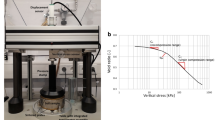Abstract
The purpose of this paper is to test the hypothesis that gradual rather than abrupt increases in strength lead to increased root penetration of strong layers. This was tested experimentally in a model system with multi-layered wax discs with a total thickness of up to 6 mm that either increased in strength with depth, or decreased in strength with depth. Strength was varied by altering the proportions of hard paraffin wax and white soft paraffin. Multi-layered wax discs consisted of three layers, each 1.5 or 2 mm thick, to give a disc thickness of either 4.5 or 6 mm. ‘Test’ wax discs had a 40% hard wax layer above a 60% wax layer, which was above an 80% wax layer. This led to a gradual increase in strength as roots encountered the disc from the sand growing medium. In ‘control’ discs, the order was reversed so that 80% wax was encountered immediately below the sand. These treatments were used to challenge roots of the rice cvs. Azucena and Bala. Compared with the control, the test layers increased root penetration of Azucena from a mean of 5.9 root axes to 12.4, while penetration of Bala was increased from 0.5 to 5.6. These results show that there was increased root penetration when roots encountered a gradual increase in strength rather than a sudden increase in strength. This was explored further with numerical simulations of stress distributions at the tips of roots. These simulations indicated that gradual rather than abrupt increases in strength decreased stress concentration at the root tip, consistent with the experimental results.





Similar content being viewed by others
References
Botwright Acuña TL, Pasuquin E, Wade LJ (2007) Genotypic differences in root penetration ability of wheat through thin layers in contrasting water regimes and in the field. Plant Soil 301:135–149
Cairns JE, Audebert A, Townend J, Price AH, Mullins CE (2004) Effect of soil mechanical impedance on root growth of two rice varieties under field drought stress. Plant Soil 267:309–318
Clark LJ, Aphalé SL, Barraclough PB (2000) Screening the ability of rice roots to overcome the mechanical impedance of wax layers: importance of test conditions and measurement criteria. Plant Soil 219:187–196
Clark LJ, Cope RE, Whalley WR, Barraclough PB, Wade LJ (2002) Root penetration of strong soil in rainfed lowland rice: comparison of laboratory screens with field performance. Field Crops Res 76:189–198
Dexter AR, Hewitt JS (1978) The deflection of plant roots. J Agric Eng Res 23:17–22
Kirby JM, Bengough AG (2002) Influence of soil strength on root growth: experiments and analysis using a critical-state model. Eur J Soil Sci 53:119–127
Kotsiomiti E, McCabe JF (1997) Experimental wax mixtures for dental use. J Oral Rehab 24:517–521
Kundu DK, Ladha JK, Lapitan de Guzman E (1996) Tillage depth influence on soil nitrogen distribution and availability in a rice lowland. Soil Sci Soc Am J 60:1153–1159
Manzini G, Ferraris S (2004) Mass-conservative finite volume methods on 2-D unstructured grids for the Richards’ equation. Adv Wat Resour 27:1199–1215
Mambani B, Lal R (1983) Response of upland rice varieties to drought stress. II. Screening rice varieties by means of variable moisture regimes along a toposequence. Plant Soil 73:73–94
Materechera SA, Dexter AR, Alston AM (1991) Penetration of very strong soils by seedling roots of different plant species. Plant Soil 135:31–41
Price AH, Steele KA, Moore BJ, Barraclough PB, Clark LJ (2000) A combined RFLP and AFLP linkage map of upland rice (Oryza sativa L.) used to identify QTLs for root-penetration ability. Theor Appl Genet 100:49–56
Ray JD, Yu L, McCouch SR, Champoux MC, Wang G, Nguyen HT (1996) Mapping quantitative trait loci associated with root penetration ability in rice (Oryza sativa L.). Theor Appl Genet 92:627–636
Samson BK, Hasan M, Wade LJ (2002) Penetration of hardpans by rice lines in the rainfed lowlands. Field Crops Res 76:175–188
Wade LJ, Fukai S, Samson BK, Ali A, Mazid MA (1999) Rainfed lowland rice: physical environment and cultivar requirements. Field Crops Res 64:3–12
Whalley WR, Clark LJ, Finch-Savage WE, Cope RE (2004) The impact of mechanical impedance on the emergence of carrot and onion seedlings. Plant Soil 265:315–323
Yu L, Ray JD, O'Toole JC, Nguyen HT (1995) Use of wax-petrolatum layers for screening rice root penetration. Crop Sci 35:684–687
Zienkiewicz OC, Taylor RL, Zhu JZ (2005) The finite element method: its basis and fundamentals. Elsevier, Amsterdam 733 pp
Acknowledgements
This work was funded by the UK’s Biotechnology and Biological Sciences Research Council (BBSRC) under grant BB/C507837/1. Rothamsted Research is grant-aided by the BBSRC.
Author information
Authors and Affiliations
Corresponding author
Additional information
Responsible Editor: Len Wade.
Rights and permissions
About this article
Cite this article
Clark, L.J., Ferraris, S., Price, A.H. et al. A gradual rather than abrupt increase in soil strength gives better root penetration of strong layers. Plant Soil 307, 235–242 (2008). https://doi.org/10.1007/s11104-008-9602-8
Received:
Accepted:
Published:
Issue Date:
DOI: https://doi.org/10.1007/s11104-008-9602-8




